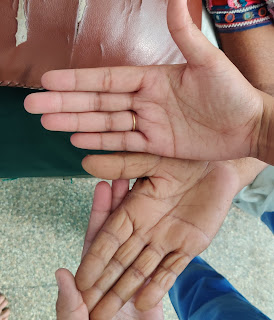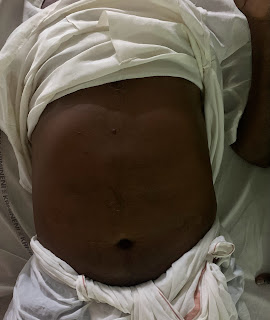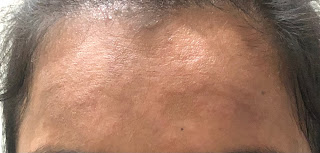1. What is the problem representation of this patient and what could be the anatomical site of lesion ?
ANS) 55yr old man, maestri by occupation who is an alcoholic(30yr's),diabetic(5yr's) has GTCS for 2min followed by multiple episodes of Focal seizures of right upper limb and right lower limb with uprolling of eye balls and post ictal confusion
Anatomical site:Left front parietal cortex
2. Why are subcortical internal capsular infarcts more common that cortical infarcts?
ANS)The blood supply of the internal capsule is variable but is commonly from small perforating branches of the middle cerebral artery and anterior cerebral artery. These include the lateral lenticulostriate arteries and the recurrent artery of Heubner respectively .
An internal capsule stroke is caused by interruption of blood supply in the middle cerebral artery (MCA) or one of its small branches. ... It may also be caused by a thrombotic blood clot developing within one of the small arteries that supply oxygen-rich blood to the internal capsule.
These penetrating arteries arise at sharp angles from major vessels and are thus, anatomically prone to constriction and occlusion.Bcz of these subcortical internal capsular infarcts more common that cortical infarcts
3.3. What is the pathogenesis involved in cerebral infarct related seizures?
Cerebrovascular diseases, including stroke, are viewed as the most common cause of epilepsy in the elderly population, accounting for 30%-50% of the newly diagnosed cases of epilepsy cases in this age group.
Post-stroke seizures (PSS) have been classified as occurring immediately before, immediately after (24 hours), or of early or late onset. Early-onset seizures are considered to be provoked seizures, which occurred within 1 week or 2 weeks after stroke and caused by the acute metabolic and physiological derangement associated with acute infarction. Late-onset seizures after 2 weeks of stroke are considered to be unprovoked seizures that originate from the areas of partially injured brain where neuronal networks have undergone anatomical and physiological alterations, predisposing them to hyperexcitability and synchronization .
ATHOPHYSIOLOGY:
If so why?
Antiepileptic drugs (AEDs) with fewer adverse effects, including cognitive effects, and AEDs without significant pharmacokinetic drug interactions are needed
6.Question 2) 55 year old man with Recurrent hypoglycemia
Questions:
1. What is the problem representation for this patient?
1)55yrs old man presented vtha) hypoglycemic episodes ? sec to drug induced b)hypoalbunemia ?sec to renal failure (spot protein/creat ratio 3.19) 24hrs urine protein not available? as diabetic nephropathy is leading cause for renal failure. c)anemia(hb 9.7)
2. What is the cause for his recurrent hypoglycemia? And how would you evaluate?
Drug induced hypoglycemia because kidney failure (increased duration of action of OHA due to decreased excretion)
Glimepiride is metabolized by the liver to two major metabolites each of which has hypoglycemic activity. In renal disease these metabolites summed. Although the half-life is 5-7 h, the drug can cause severe hypoglycemia that lasts more than 24hrs. along vth insulin clearence is reduced.
Approach to drug induced hypoglycaemia
3. What is the cause for his Dyspnea? What is the reason for his albumin loss?
4. What is the pathogenesis involved in hypoglycemia ?
There is no signs of sepsis, and hence use of antibiotics is not necessary.
QUESTION-3
A 41 year old man with Polyarthralgia
Case details here: https://
1. How would you evaluate further this patient with Polyarthralgia?
3. What are the treatment regimens for a patient with RA and their efficacies?3)Treatment regimens:
1.What are your differentials for this patient and how would you evaluate?
-Transfusion related acute hepatic injury (TRAHI)
-Post transfusion hepatitis
-Ischemic hepatitis
coombs testing
antibody panel testing
Treatment is only supportive management with no role of udiliv as the cause for hepatitis is self resolving with increased about of bilirubin due to destruction of rbc as substrate for hepatitis.
2. What are the factors contributing to her uncontrolled blood sugars?
4. What do you think is the cause for her hypoalbuminaemia? How would you approach it?
The potential causes of hypoalbuminemia are many, and include:
Hepatic failure (failure of albumin synthesis)
Gastrointestinal protein loss (protein-losing enteropathy)
Renal protein loss (protein-losing nephropathies)
Other external losses in exudate or hemorrhage
Hyperglobulinemia (with a 'compensatory' decrease in albumin production)
Starvation/protein malnutrition
Chronic illness
Hypoadrenocorticism
Laboratory error
the cause in this patient can be attributes to malnutrition or albumin as acute phase reactant
5. Comment on the treatment given along with each of their efficacies with supportive evidence.
- Piptaz & clarithromycin : for his right upper lobe pneumonic consolidation and sepsis
- Egg white & protien powder : for hypoalbuminemia
- Lactulose : for constipation
- Actrapid / Mixtard : for hyperglycemia
- Tramadol : for pain management
- Pantop : to prevent gastritis
- Zofer : to prevent vomitings
5) 56 year old man with Decompensated liver disease
Case report here: https://appalaaishwaryareddy.
1. What is the anatomical and pathological localization of the problem?
2. How do you approach and evaluate this patient with Hepatitis B?Laboratory evaluation of hepatitis B disease generally consists of liver enzyme tests, including levels of alanine aminotransferase (ALT) and/or aspartate aminotransferase (AST), alkaline phosphatase (ALP), and gamma-glutamyl transpeptidase (GGT), as well as liver function tests (LFTs) that include total and direct serum bilirubin, albumin, and the measurement of the international normalized ratio (INR).Hematologic and coagulation studies also include a platelet count and a complete blood count (CBC). Ammonia levels may be obtained, but the results often create diagnostic confusion in clinicians.
Serologic tests for hepatitis B surface antigen (HBsAg) and hepatitis B core antibody (anti-HBc) immunoglobulin M (IgM) are required for the diagnosis of acute hepatitis B virus (HBV). HBsAg is positive in both acute and chronic HBV infection; however, the presence of IgM anti-HBc is diagnostic of acute or recently acquired infection.Antibody to HBsAg (anti-HBs) is produced after a resolved infection and is the only HBV antibody marker present after vaccination. The presence of HBsAg and total anti-HBc, with a negative test for IgM anti-HBc, indicates chronic HBV infection; the absence of IgM anti-HBc or the persistence of HBsAg for 6 months indicates chronic HBV infection. The presence of anti-HBc alone might indicate acute, resolved, or chronic infection or a false-positive result.
A positive result suggests not only the likelihood of active hepatitis but also that the disease is much more infectious, as the virus is actively replicating.
HBV DNA testing is also recommended when occult HBV is suspected (positive anti-HBc and negative antibody to HBsAg [anti-HBs] and HBsAg) or in cases in which all of the serologic tests are negative.
3. What is the pathogenesis of the illness due to Hepatitis B?
The pathogenesis and clinical manifestations of hepatitis B are due to the interaction of the virus and the host immune system, which leads to liver injury and, potentially, cirrhosis and hepatocellular carcinoma.
4. Is it necessary to have a separate haemodialysis set up for hepatits B patients and why?
It could remain viable for at least 7 days on environmental surfaces at room temperature.[12] Being a blood handling procedure, hemodialysis, therefore, poses an exceptional risk to dialysis patients as well as clinical staff in terms of nosocomial transmission of HBV. The patients could acquire the infection through injections of contaminated material, having mucosal membrane or breached skin exposed to infective material or being dialyzed with contaminated equipment
HBV DNA had been detected even in the dialysate and ultrafiltrate of those HBsAg positive undergoing high-flux hemodialysis,
There should be no sharing of supplies, vials, medications, instruments and even ancillary items such as clamps, scissors, blood pressure cuffs and other non-disposable items. Previous studies, indeed, showed that non-separation of infected from non-infected patients was associated with an increased risk of infection while segregation has been shown to be effective
5. What are the efficacies of each treatment given to this patient? Describe the efficacies with supportive RCT evidence.
Lactulose : for prevention and treatment of hepatic encephalopathy. https://pubmed.ncbi.nlm.nih.gov/27089005/
Tenofovir : for HBV
Octreotide : for upper GI bleed.
Lasix : for fluid overload (AKI on CKD)
Vitamin -k : for ? Deranged coagulation profile (PT , INR & APTT reports not available)
Pantop : for gastritis
Zofer : to prevent vomitings
Monocef (ceftriaxone) : for AKI (? renal)
QUESTION-6
6) 58 year old man with Dementia
Case report details:http://jabeenahmed300.blogspot.com/2020/12/this-is-online-e-log-book-to-discuss.html
1. What is the problem representation of this patient?
ANS) Forgetfulness since 3 months impairing his daily activitiesDeviation of mouth ,leading to slurring of speech and unable to swallow since one month which increased
Altered sensorium (delirium) with intact awareness , fluctuations .
Urinary urge incontinence since 6 months.
Forgetfulness since 3 months.
He has delayed response to commands.
Dysphagia to both solids and liquids since 10 days.
2. How would you evaluate further this patient with Dementia?
3. Do you think his dementia could be explained by chronic infarcts?
Vascular dementia signs and symptoms include:
- Confusion
- Trouble paying attention and concentrating
- Reduced ability to organize thoughts or actions
- Decline in ability to analyze a situation, develop an effective plan and communicate that plan to others
- Difficulty deciding what to do next
- Problems with memory
- Restlessness and agitation
- Unsteady gait
- Sudden or frequent urge to urinate or inability to control passing urine
- Depression or apathy
- Sometimes a characteristic pattern of vascular dementia symptoms follows a series of strokes or ministrokes. Changes in your thought processes occur in noticeable steps downward from your previous level of function, unlike the gradual, steady decline that typically occurs in Alzheimer's disease dementia.
- Multi-Infarct Dementia Information Page | National Institute of ...www.ninds.nih.gov › Disorders › All-Disorders › Multi-I...
4. What is the likely pathogenesis of this patient's dementia?
(1) Neurotoxicity, including dysregulated glutamate and calcium signaling, and neurotransmission imbalance contribute to synaptic dysfunction and neuronal loss
(2) Glia activation, including microglia and astrocytes, interfere with immunological processes in the brain further promoting non-resolving inflammation and neurodegeneration
(3) Tau phosphorylation and neurofibrillary tangle formation;
(4) Aβ plaque formation are key hallmarks of the AD brain. Specialized pro-resolving mediators and strategies aimed at boosting resolution such as using omega-3 polyunsaturated fatty acid exert differential effects on these targets and provide anti-inflammatory and pro-cognitive effects in neuroinflammation/degeneration
(5) The accumulation of Aβ may lead to the microglial accumulation and activation resulting in increases in pro-inflammatory cytokines such as interleukin-1 beta, interleukin-6, and tumor necrosis factor-alpha. These cytokine increases in the brain can subsequently lead to tau hyperphosphorylation and a pathological cycle of increased Aβ deposition and persistent microglial activation, ultimately resulting in chronic neuroinflammation and neurodegeneration.
- Donepezil
- Rivastigmine
- Galantamine
- Memantine
- Counselling the patient and care givers
- Geriatric care
- Cognitive / emotion oriented interventions
- Sensory stimulation interventions
- Behaviour management techniques
7) 22 year old man with seizures
Case report http://geethagugloth.
1. What is the problem representation of this patient ? What is the anatomic and pathologic localization in view of the clinical and radiological findings?
3. What is "immune reconstitution inflammatory syndrome IRIS and how was this patient's treatment modified to avoid the possibility of his developing it?
ANS) A paradoxical clinical worsening of a known condition or the appearance of a new condition after initiating antiretroviral therapy in HIV-infected patients is defined as immune reconstitution inflammatory syndrome (IRIS).






Comments
Post a Comment